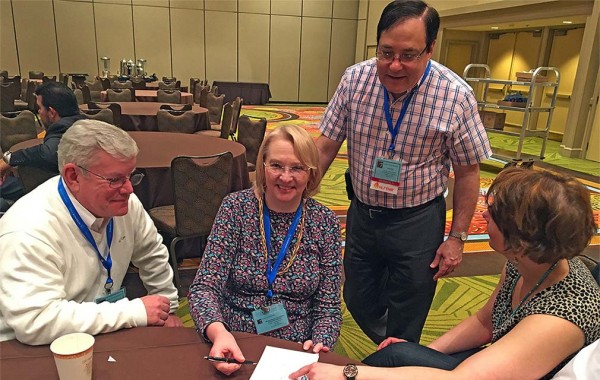Jackie “JP” (Downing) Mulrooney ’79
Like nearly everything else today, your medical records — from hospital stays and doctor visits to prescriptions and lab results — are being converted to electronic records from paper ones and stored in Electronic Health Record (EHR) systems, which let health care providers access your records to provide better care. But what happens when the patient records system used by one provider is different than another, or when a heart attack at hospital A is called a myocardial infarction at hospital B and cardiac arrest at hospital C?
It’s an issue that Jackie “JP” (Downing) Mulrooney ’79 has been tackling for nearly a decade as longtime president and founder of J P Systems, a Clifton, Va.–based health care information technology firm. “When two providers can’t exchange information, it may eventually cause patient safety issues,” said Mulrooney. “The interoperability of systems is a problem not just nationally, but worldwide.” Since 1998, when her husband, Galen, joined her firm, the company has focused on electronic patient records, health care standards, and data architecture for health care IT. Together, they oversee everything from marketing and management to human resources and sales.
In September 2015, the company was awarded a five-year U.S. Department of Veterans Affairs contract with a $100 million ceiling to support standardization efforts for the coding of medical terms. It’s the largest contract to date that the Mulrooneys’ rapidly growing small business has received.
“It is for health care IT data standards, which is our company’s niche,” Mulrooney said. “Over the last 30 years, medical concepts have been assigned different codes in different systems. That is why electronic data exchange is so very difficult.”
There are other issues with EHRs, too. “If organizations have different missions, they’ll collect and store different types of data at different levels of specificity,” she said. “A cancer center will collect and store different details about a patient than a general practitioner at a local clinic. The goal is to get them to map to one international standard so that patient data can be exchanged in an accurate way. You can’t make good clinical decisions without accurate, up-to-date, and complete information.”
At Colgate, Mulrooney was a pre-med, computer science, and chemistry combined major, which built the foundation for what she does today. She was one of the few women studying computer science at the time. The ambitious Mulrooney worked full time during her junior year, programming for Wilson Greatbatch Ltd., the company that made cardiac pacemaker batteries. She used AP credits, summer coursework, and night school classes at the University of Buffalo to graduate on time.
With a year of programming under her belt, Mulrooney found plenty of database design work in Washington, D.C., post-graduation. After four years, she began J P Systems in 1983. The bulk of her time involved defense logistics.
When asked about the number of women working in IT today, Mulrooney said, “I expected more progress by now.” According to an American Association of University Women study, the number of female computing professionals has actually fallen, from 35 percent in 1990 to 26 percent in 2013, and women that year made up just 18 percent of U.S. computer science graduates.
She credits much of her success to mental attitude, and has a library of books on success principles that she revisits. “You have to believe you can succeed,” said Mulrooney. “Your belief in yourself is a large percentage of your success in business.”
— Anne Stein







